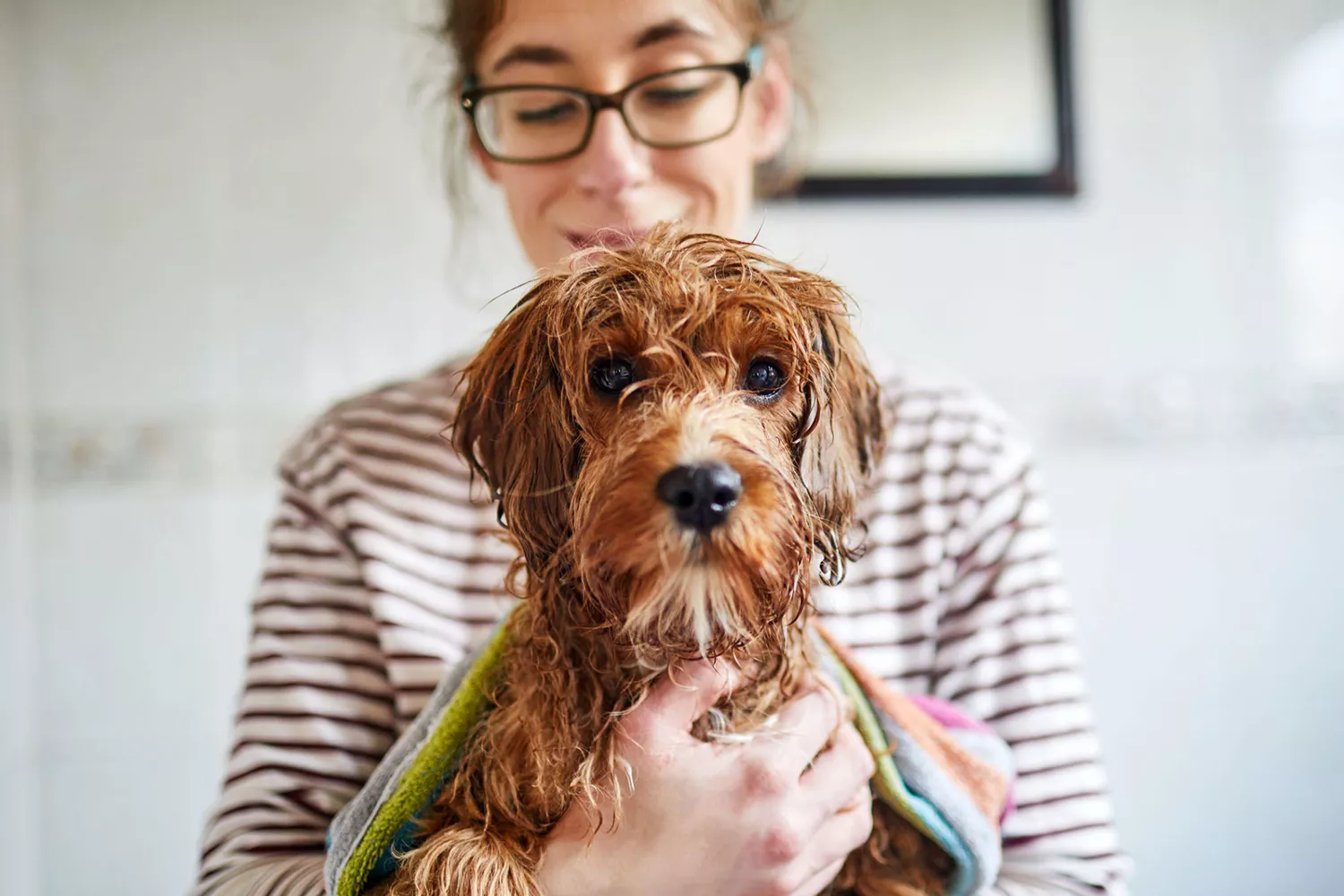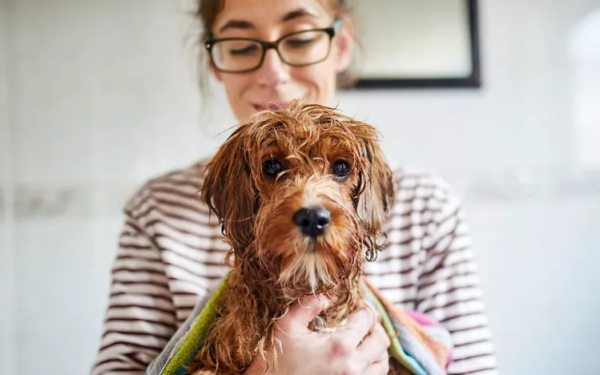Whether your dog loves baths or runs the other way when you spell “B-A-T-H,” bathing your dog regularly is an important part of caring for your pet. Linda Easton, president of International Professional Groomers and the owner of grooming salon Canine Concepts in Salem, Oregon, CPG, ICMG, shares her top tips on how to bathe a dog.
How Often Should You Bathe Your Dog?
Unless your pooch just spent the afternoon splashing in mud puddles, you probably don’t need to bathe your dog more than once a month. This is breed-dependent; some dogs with longer coats will require more frequent baths or even trips to a professional groomer. If you’re not sure how often to suds up your pup, check with a groomer or your vet. Giving a monthly bath is key, though.
“The way dog’s skin works is about every 30 days they have a whole new layer of cells,” Easton says. “So, the old cells slough off. That’s what makes dander and things like that. So regular grooming or bathing keeps that dander down.”
Key Products and Tools
Your first decision is likely choosing where you want to give your dog a bath. The size of your dog will likely influence your choice. You may be able to bathe a small dog in a kitchen sink, whereas a large dog will require more space. Some pet parents prefer a dog-specific bathtub, either a stand-alone unit or one that’s built-in at home or at a DIY dog bath facility. Using a dedicated dog bath area can keep fur and grime from clogging your family bathtub. But if you prefer to give your dog a bath in the family bathtub, that’s fine too. Just choose a place where you can safely get your dog in and out of the cleaning area.
Then, before you turn on the faucet, make sure you have all your products and tools handy. “You want to have everything you need, right where you can reach it,” Easton says. You will need:
Shampoo
Conditioner
Towels
Non-slip bath mat
Eye wash, just in case
Pick the Proper Shampoo and Conditioner
To give your dog a good bath, you’ll want to start with the right products. “Make sure you’re using shampoo that’s specifically made for dogs,” Easton says. “Dogs have different pH than people do in their skin. So, they’re actually more alkaline. If you use the shampoo that’s made for people, it can be irritating to their skin.”
If you’re bathing a puppy, puppy-specific shampoo can be a good idea, Easton says. The pH of puppy shampoo matches the pH of a dog’s eyes, meaning it won’t irritate the dog’s eyes as much if some gets into that area.

If you’re unsure of what products to select for your particular dog, ask a groomer what he or she uses. Easton advises using a mild shampoo. If your dog is experiencing a certain issue (like dry, itchy skin), then a shampoo designed to treat that condition might be ideal.
After shampooing your dog, putting on a conditioner is the next important step. “You always want to follow up when you’re grooming at home with a conditioner because when you use your shampoo you strip a lot of the natural oils out of the skin and out of the hair. So, your conditioner rehydrates the skin as well as closes up all the cells on the outside part of the hair shaft itself,” Easton says. “Basically, you’re rehydrating with the conditioner.”
Proper Dog Washing Technique
When you have chosen the right place and have the right products ready to use, the real fun begins. Here’s the bathing process our pros recommend.
Get Your Dog in the Tub
Coax or place your dog in the tub or wash station. Treats are a great way to get the process off to a positive start!
Dilute the Shampoo
Dilute the shampoo with water. Try adding some to a bowl full of water, or put the shampoo in a dispenser that contains water. Diluting shampoo helps it suds up and spread better. Easton explains that most shampoo is thick and concentrated, and adding water can make it easier to use.
Wet Your Dog
Thoroughly wet your dog using warm water. Checking the temperature with your hand is just fine, Easton says.
Shampoo Twice
Shampoo the dog twice. Easton explains that the first time, the shampoo binds with the dirt and helps get rid of it. The second go-around, you’re really washing the skin and pulling out all the remaining dirt and oil in the hair. Easton recommends a loofah sponge to help spread around the shampoo. Be sure to not overlook places like the pads of the feet, armpits, and bellies. Above all, make it an enjoyable experience. “You can use your hands to really massage the whole dog. And if you’re doing that, and you’re using warm water and the dog is someplace where it’s warm, it should be a fun experience for the dog,” she says.
Condition
Use conditioner. Leave it on for a few minutes and then rinse away.
Rinse Well
Rinse well until there is no more product on the fur. “You want to scrub them really good, but you also want to make sure that all of the soap is out. That’s probably the most important thing,” Easton says. “Because if you don’t get all the soap out, then the soap will stay on the skin and irritate it. It’s worse than not giving them a bath.”
How to Wash a Dog’s Face
Washing your dog’s head is one of the trickiest parts of the dog bathing process. You don’t want to get soap or water in sensitive areas like your dog’s ears, nose, and eyes. Easton recommends you save this part for the end of the bath and suggests using a washcloth to clean your pet’s face.
Dip the cloth in soapy water, carefully wash your dog’s head and face, and then dip a clean washcloth into clean water and use that to rinse. “You just really want to make sure all the soap is out of those areas,” Easton says.
Even if you’re using a puppy shampoo that’s designed to be easier on the eyes, shampoo can still hurt them, so you’ll want to avoid the eye area as much as possible. If shampoo does get in your dog’s eyes, have an eye wash on hand that you can use. If your dog has eye goobers, Easton suggests wetting them and then using a toothbrush to softly remove them.
How to Bathe a Dog that Hates Water
Although some dog breeds love water (we’re looking at you, golden retrievers), many dogs shudder at just the sound of the bath faucet turning on. To combat this, try giving your dog lots of positive reinforcement during the bath. Praise, treats, and overall making bath time a positive experience is key. Give your dog positive associations to remember for next time he sees you gathering the dog shampoo.
It’s also helpful to have a partner hold the dog while you’re giving him a bath, Easton says. And, if possible, start giving your dog a bath when he’s a puppy to help him get used to bath time.
What to Do Post-Bath
First, towel-dry your dog as best you can. Then, use either a dog-specific hairdryer or a human one on a medium or cool setting. Easton recommends brushing your dog as he dries. You also could air-dry your dog, as long as he doesn’t get chills or shiver too much.
If you’re air-drying your dog, “every 10 or 15 minutes run a brush through them as they’re drying, and that’ll help prevent mats or help separate mats if they have them,” Easton says.
Your reward for bath time: A dog that looks and smells fresh. And the knowledge that you’ve done something nice for your pooch’s health and handsomeness.



